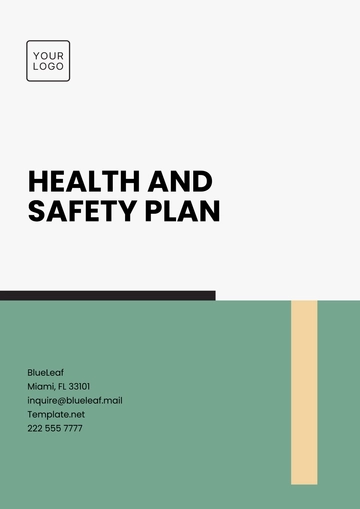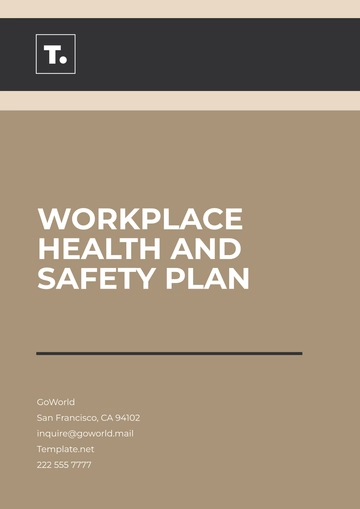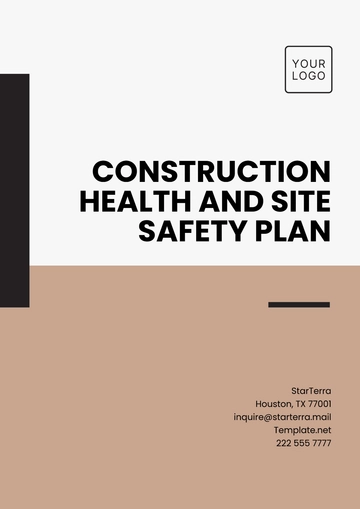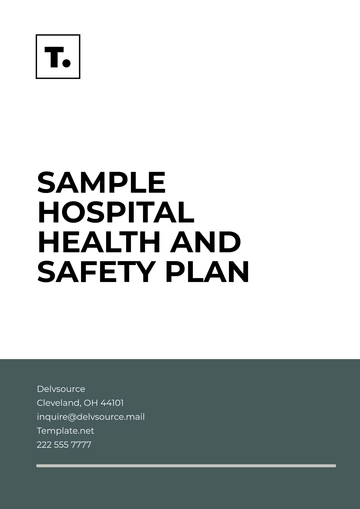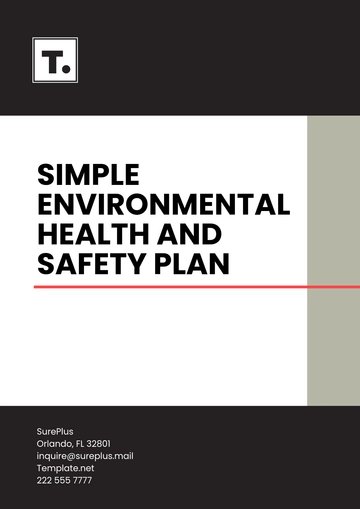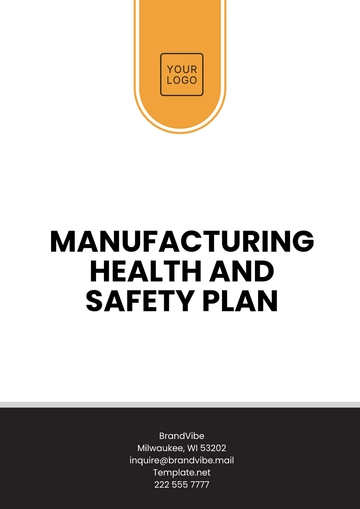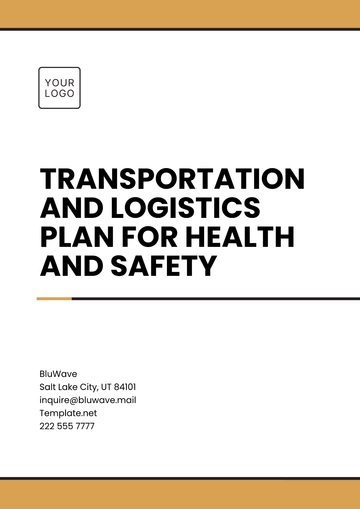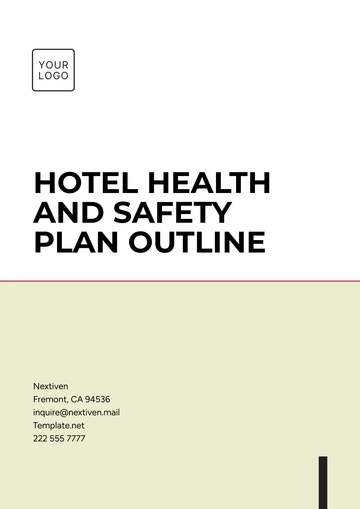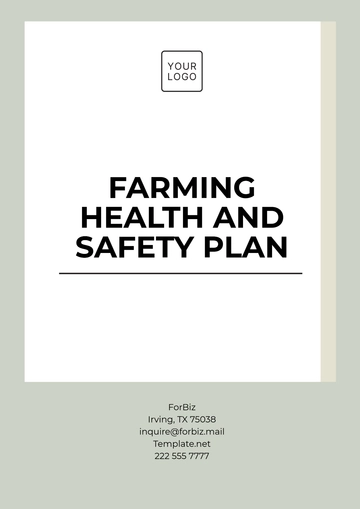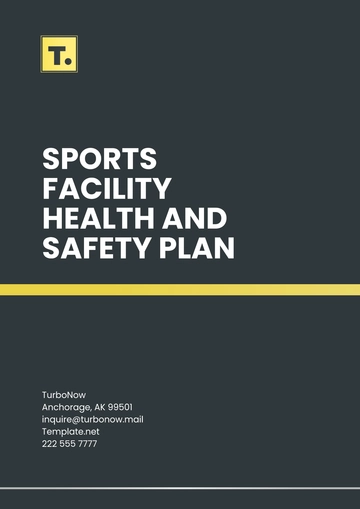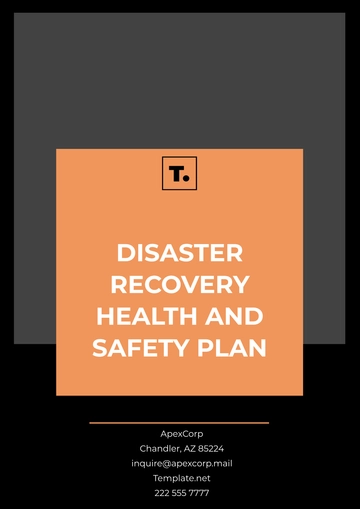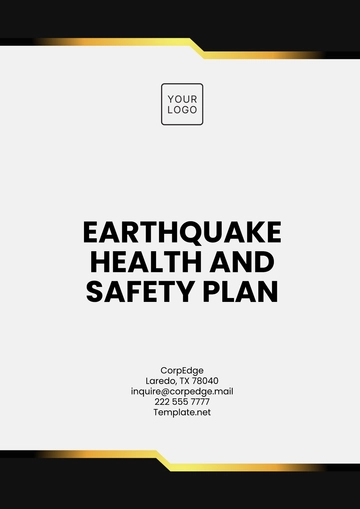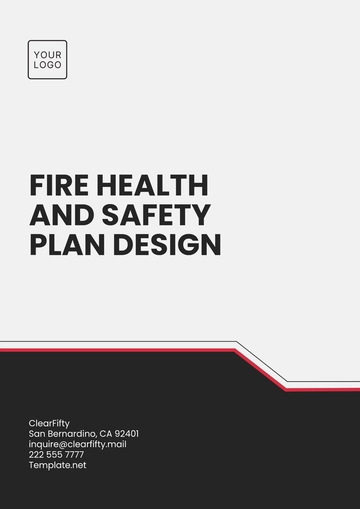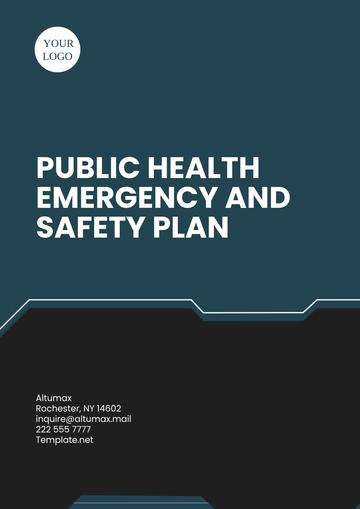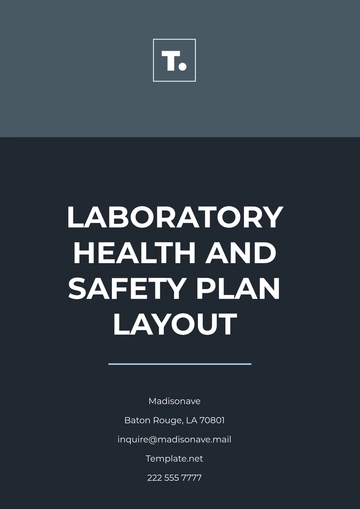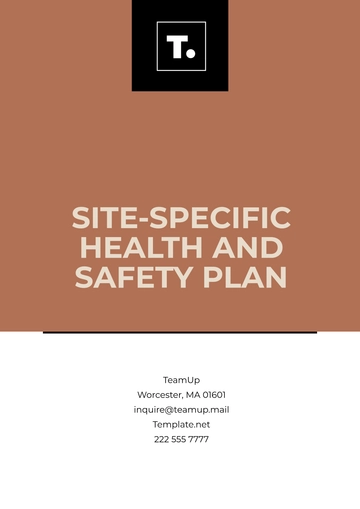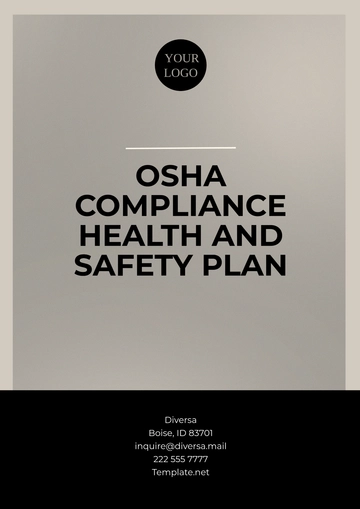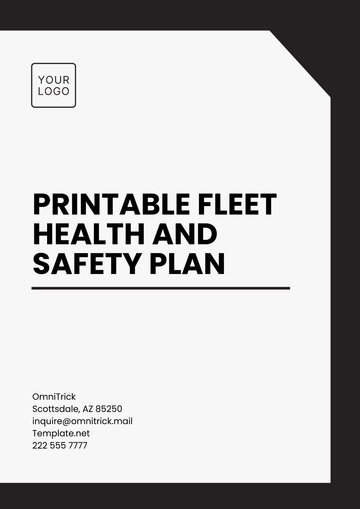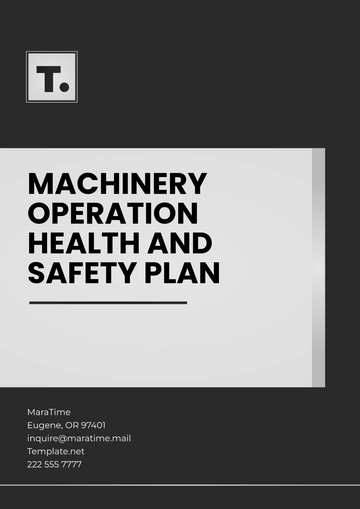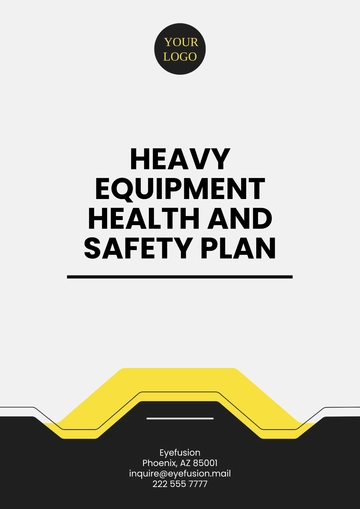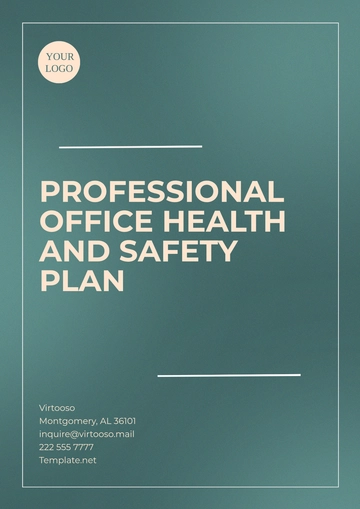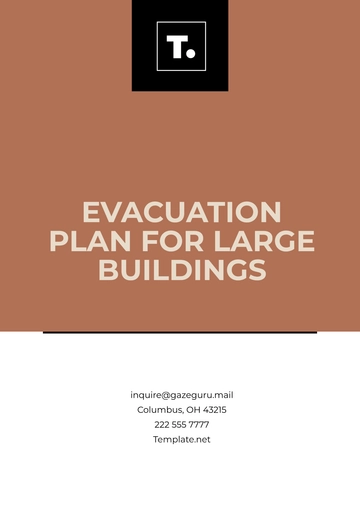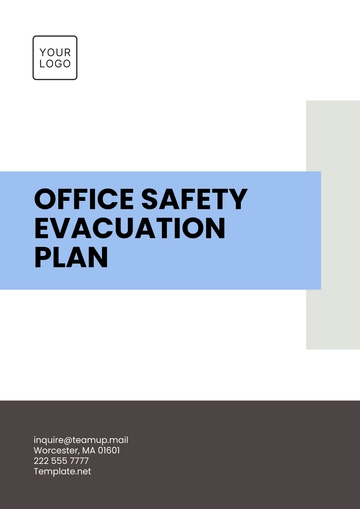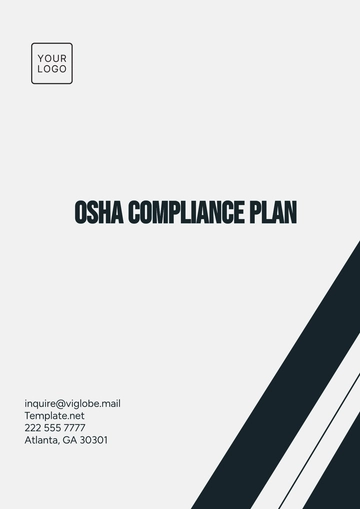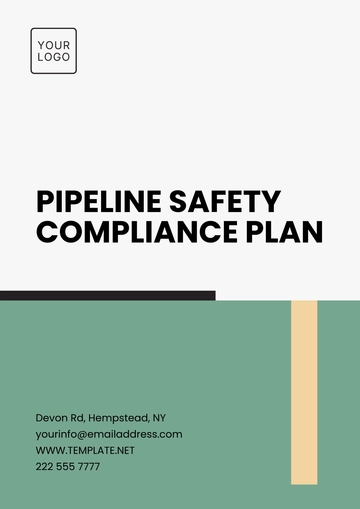Free Workplace Safety and Health Management Plan
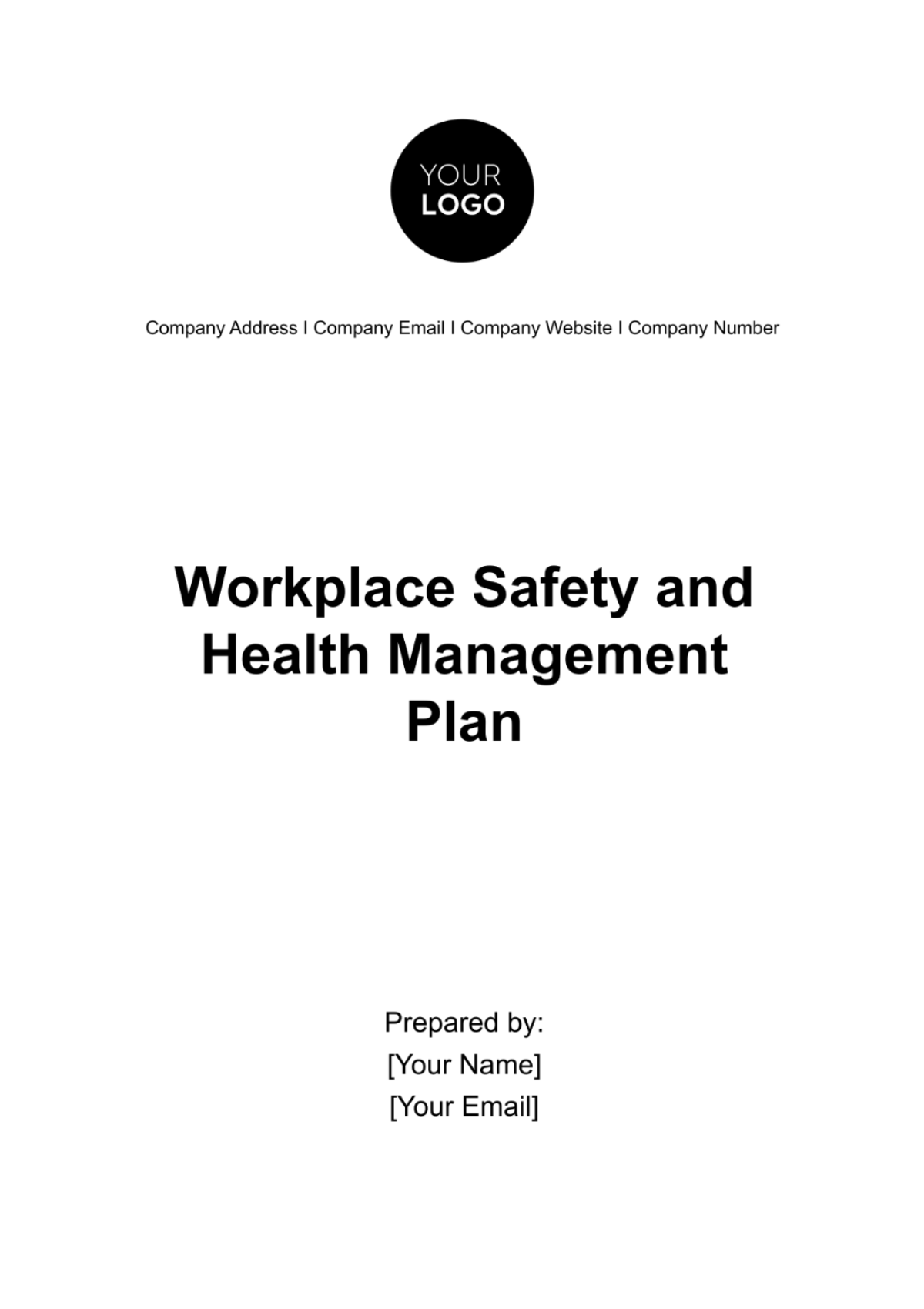
1. Introduction
Overview of [Your Company Name]'s Health and Safety Policy
At [Your Company Name], the safety and well-being of our employees, visitors, and stakeholders are of paramount importance. In alignment with our unwavering commitment to workplace safety, we have developed this Workplace Safety and Health Management Plan. This comprehensive document serves as a cornerstone in our efforts to create a secure and healthful work environment.
This management plan meticulously outlines the fundamental principles, delineates roles and responsibilities, and provides a structured framework for the procedures governing safety within our organization. Our goal is to not only meet regulatory requirements but to exceed them by fostering a culture of safety excellence.
With this plan, we underscore our dedication to proactive hazard identification, risk mitigation, incident prevention, and continuous improvement in safety performance. It is a testament to our pledge to protect the physical and mental well-being of all those connected to [Your Company Name]. By embracing this plan, we collectively contribute to a safer, healthier, and more productive workplace, ensuring that every individual returns home safely at the end of each day.
As we embark on this journey toward enhanced safety, we invite each member of our organization to embrace and champion the principles and practices detailed in this Workplace Safety and Health Management Plan. Together, we can create an environment where safety is not just a priority—it's a way of life.
2. Health and Safety Policy Statement
At [Your Company Name], safety is not just a priority; it's a fundamental value. We are unwavering in our dedication to maintaining a safe and healthy work environment for every member of our organization, visitors, and contractors. Our commitment is rooted in several core principles:
Preventing Accidents, Injuries, and Illnesses: We are resolute in our efforts to proactively identify and eliminate potential hazards to prevent accidents, injuries, and illnesses. Safety is the foundation upon which all our operations are built.
Complying with Applicable Laws and Regulations: We hold ourselves to the highest standards of compliance with all relevant laws and regulations. It is our duty to ensure that every aspect of our operations adheres to these guidelines, and we continuously monitor and adjust our practices to remain in full compliance.
Continuous Improvement of Safety Performance: Safety is not a static goal; it is an ongoing journey. We are committed to continuously improving our safety performance by learning from experiences, implementing best practices, and embracing innovative safety measures.
Objectives of the Policy
The key objectives of our Health and Safety Policy are both straightforward and ambitious:
Identifying and Mitigating Workplace Hazards: Our first objective is to identify and mitigate workplace hazards effectively. We employ rigorous hazard identification processes to ensure that all risks are recognized and addressed promptly.
Ensuring Employee Awareness of Safety Procedures: We recognize that awareness is a crucial component of safety. Our second objective is to ensure that all employees are well-informed and trained in safety procedures, empowering them to actively contribute to a safer workplace.
Promptly Addressing Safety Concerns and Incidents: Safety concerns and incidents, no matter how minor, require immediate attention. Our third objective is to create a culture where safety concerns are reported without hesitation and addressed promptly, preventing potential escalation.
Regularly Reviewing and Updating the Policy: Our final objective is the commitment to regularly review and update our Health and Safety Policy. The dynamic nature of safety requires us to adapt to changing circumstances, new regulations, and emerging best practices. We pledge to keep this policy current and effective.
[Your Company Name] is resolute in its commitment to these principles and objectives. We believe that a steadfast dedication to safety not only protects our workforce but also enhances productivity and fosters a workplace culture where each individual thrives. Together, we strive for a safer, healthier, and more secure workplace for all.
3. Roles and Responsibilities
We delineate the crucial roles and responsibilities within our organization concerning workplace safety. A clear understanding of these roles is essential for the effective implementation of our safety policies and procedures.
Management Responsibilities
Management plays a pivotal role in setting the tone and direction for safety within our organization. Their specific responsibilities include:
Responsibility | Description |
Setting Safety Objectives and Policies | Management is responsible for defining the overarching safety objectives and policies that guide our safety efforts. These objectives set the framework for our safety programs and initiatives. |
Allocation of Resources | Adequate resources, including personnel, budget, and equipment, must be allocated to support safety programs. Management ensures that the necessary resources are available for safety initiatives. |
Hazard Identification and Mitigation | Identifying and mitigating workplace hazards is a continuous process. Management leads efforts to proactively identify and eliminate potential risks to ensure a safer work environment. |
Compliance with Regulations | Management oversees compliance with all applicable laws, regulations, and industry standards related to safety. This includes monitoring changes in regulations and ensuring timely adjustments. |
Incident Reporting and Investigation | In the event of incidents, management ensures that appropriate reporting and investigation procedures are followed. They facilitate the investigation process and support corrective actions. |
Safety Communication | Effective communication of safety policies, procedures, and updates is vital. Management plays a key role in disseminating safety information to employees, ensuring understanding and awareness. |
Monitoring and Review | Regular monitoring and review of safety performance are essential. Management conducts periodic safety audits, assessments, and reviews to identify areas for improvement and take corrective actions. |
Employee Responsibilities
Employees are vital participants in our safety culture, and their responsibilities include:
Responsibility | Description |
Compliance with Safety Policies | Employees are expected to adhere to all safety policies, procedures, and guidelines in the workplace rigorously. |
Reporting Safety Concerns | Employees must promptly report any safety concerns, hazards, near-misses, or incidents they encounter during work. |
Safe Work Practices | Adhering to safe work practices and using prescribed personal protective equipment (PPE) are essential for workplace safety. |
Participation in Training | Employees are encouraged to actively participate in safety training programs and awareness campaigns provided by the company. |
Emergency Response | In the event of emergencies, employees are expected to follow emergency response procedures and assist others as needed. |
Support for Safety Initiatives | Employees are encouraged to support and actively engage in safety initiatives, contributing to a safer work environment. |
These roles and responsibilities, meticulously defined and embraced by both management and employees, are foundational to our commitment to a safe and secure workplace at [Your Company Name].
4. Risk Assessment
We delve into the critical process of risk assessment—a fundamental aspect of our commitment to workplace safety at [Your Company Name]. Risk assessment is the cornerstone of proactive hazard identification, allowing us to address potential risks before they result in accidents or incidents.
Identifying Workplace Hazards
Risk assessment begins with a meticulous identification of workplace hazards. This process involves several key elements:
Process Element | Description |
Regular Workplace Inspections | Scheduled and unscheduled inspections are conducted to identify potential hazards. These inspections encompass all areas of our operations, including facilities, equipment, and processes. |
Employee Reporting | We encourage all employees to report any safety concerns or hazards they encounter during their work. An anonymous reporting system is also available for those who prefer confidentiality. |
Risk Assessments | Risk assessments are conducted for specific tasks, projects, or processes that are deemed potentially hazardous. These assessments involve a systematic examination of the task, potential risks, and mitigation strategies. |
Hazard Identification Tools | We utilize various hazard identification tools, such as checklists, job safety analyses (JSAs), and incident reports, to systematically identify and document hazards. |
Risk Evaluation and Control Measures
Once hazards are identified, [Your Company Name] takes immediate action to evaluate and control the associated risks. This involves several crucial measures and procedures:
Process Element | Description |
Risk Prioritization | We assess the severity and likelihood of each identified hazard to prioritize them based on potential impact. |
Control Measures | Specific control measures are implemented to mitigate identified risks. These measures may include engineering controls, administrative controls, or personal protective equipment (PPE). |
Documentation | All risk assessments and control measures are thoroughly documented, ensuring transparency and accountability. |
Continuous Monitoring | We continually monitor the effectiveness of control measures and adjust them as needed to maintain a safe working environment. |
Employee Training | Employees are trained in recognizing and managing risks associated with their tasks or roles. This training empowers them to actively participate in risk reduction. |
By adopting a systematic approach to risk assessment and mitigation, [Your Company Name] aims to create a safer and more secure work environment for all individuals involved. This commitment to identifying, evaluating, and controlling risks aligns with our overarching goal of fostering a culture of safety excellence.
5. Incident Reporting and Investigation
This chapter addresses the crucial aspects of incident reporting and investigation—essential components of our commitment to transparency, accountability, and continuous improvement in workplace safety at [Your Company Name].
Reporting Procedures
Effective reporting procedures are the linchpin of identifying and addressing incidents or safety concerns. Our procedures are designed to ensure that all safety-related issues are reported and handled promptly and effectively. Key components include:
Procedure | Description |
Timely Reporting | Incidents or safety concerns must be reported promptly to ensure that immediate action can be taken. |
Confidential Reporting | We offer a confidential reporting mechanism to allow employees to report concerns without fear of reprisal. |
Reporting Channels | Clear reporting channels are provided to ensure that employees know where and how to report incidents. |
Reporting Forms | Standardized reporting forms are available to capture essential details and facilitate consistent reporting. |
Investigation Process
Our investigation process ensures that incidents are thoroughly examined, and their root causes identified to prevent recurrence. The process encompasses:
Investigation Aspect | Description |
Investigation Team | A dedicated team is responsible for conducting investigations, comprising individuals with expertise in the specific incident type. |
Evidence Collection | All pertinent evidence related to the incident is collected, preserved, and documented for analysis. |
Interviews | Key personnel and witnesses are interviewed to gather insights into the incident and its contributing factors. |
Root Cause Analysis | A comprehensive root cause analysis is performed to identify the underlying causes and contributing factors of the incident. |
Documentation | Detailed documentation of the investigation process and findings is essential for accountability and future reference. |
Corrective Actions
The ultimate aim of an incident investigation is to prevent recurrence and enhance safety. Corrective actions play a pivotal role in this process:
Corrective Action Aspect | Description |
Corrective Action Planning | A systematic plan is developed to address the identified root causes and prevent similar incidents in the future. |
Priority Setting | Priorities are established to address the most critical issues first, ensuring efficient allocation of resources. |
Implementation | The planned corrective actions are implemented promptly and effectively, with clear responsibilities assigned. |
Monitoring | Ongoing monitoring of the corrective actions ensures their effectiveness and allows for adjustments as necessary. |
Employee Feedback | Employees' feedback and input are actively sought and integrated into the corrective action process. |
We view incident reporting and investigation as essential tools for learning, improving, and preventing future incidents. Our commitment to transparency and accountability drives us to embrace these processes, making our workplace safer and more secure for all.
6. Emergency Response Plan
The chapter comprehensively outlines our Emergency Response Plan, a critical component of our commitment to safeguarding the well-being of our employees and stakeholders at [Your Company Name]. This plan encompasses evacuation procedures, first aid and medical assistance, and communication strategies during emergencies.
Evacuation Procedures
Our evacuation procedures are designed to ensure the safe and orderly evacuation of all individuals in the event of emergencies. Key elements include:
Procedure Element | Description |
Evacuation Routes | Clearly marked evacuation routes are established, guiding individuals to safe locations away from potential hazards. |
Assembly Points | Designated assembly points are identified to account for all personnel and ensure their safety during evacuations. |
Specialized Procedures | Specific emergency scenarios may require specialized procedures, such as those for fire, chemical spills, or severe weather events. |
First Aid and Medical Assistance
We prioritize the availability of first aid and medical assistance on-site to provide immediate care to individuals in need. Our provisions include:
Provision | Description |
First Aid Stations | Well-equipped first aid stations are strategically located to provide initial care for minor injuries or illnesses. |
Trained First Aiders | Trained individuals, designated as first aiders, are readily available to administer basic first aid and support as needed. |
Emergency Medical Services | In more severe cases, emergency medical services are promptly summoned to provide professional medical care and transportation. |
Communication during Emergencies
Clear and effective communication is imperative during emergencies. We have established communication procedures to ensure the dissemination of crucial information:
Communication Aspect | Description |
Emergency Contact List | A comprehensive emergency contact list is maintained, including contact information for key personnel and external agencies. |
Emergency Communication Devices | Communication devices, such as two-way radios and emergency notification systems, are utilized to relay important information. |
Social Media Updates | During emergencies, official social media channels are used to provide real-time updates and instructions to employees and stakeholders. |
Our Emergency Response Plan serves as a blueprint for maintaining order, safety, and well-being during unforeseen events. At [Your Company Name], we are committed to thorough preparation and swift action to ensure the safety and security of all individuals associated with our organization.
7. Safety Performance Metrics
This chapter focuses on the core component of our commitment to continual improvement in workplace safety at [Your Company Name]. These metrics serve as invaluable tools for assessing and enhancing our safety practices.
Tracking and Measurement
Efficient tracking and measurement of safety performance enable us to identify areas for improvement and ensure our safety initiatives remain effective. This involves several critical components:
Measurement Aspect | Description |
Key Safety Metrics | We establish key safety metrics that align with our safety objectives, allowing us to measure our performance accurately. |
Data Collection | A robust data collection process is implemented to gather relevant safety data, ensuring its accuracy and completeness. |
Leading Indicators | We utilize leading indicators to proactively identify potential safety issues, allowing for preventive measures before incidents occur. |
Benchmarking
Benchmarking efforts are integral to our commitment to safety excellence. By comparing our safety performance to industry standards and best practices, we gain valuable insights and motivation for improvement. Key elements include:
Benchmarking Aspect | Description |
Industry Comparisons | We regularly compare our safety performance with industry benchmarks to gauge our standing and identify opportunities for improvement. |
External Comparisons | Comparing our safety practices with external organizations allows us to adopt best practices and learn from their successes. |
Sharing Best Practices | We actively share our own best practices with others while embracing those that have proven successful in the industry. |
Continuous Improvement
The pursuit of continuous improvement is at the heart of our safety culture. We continually strive to enhance safety practices and foster a safer work environment. Our approach includes:
Improvement Aspect | Description |
Root Cause Analysis | Thorough root cause analysis is conducted for incidents to identify underlying causes and prevent recurrence. |
Lessons Learned | Valuable lessons learned from incidents, near-misses, and safety initiatives are documented and applied to future practices. |
Safety Leading Culture | We promote a safety-leading culture that encourages proactive safety measures and empowers all employees to prioritize safety. |
Safety performance metrics are not merely numbers; they are the compass guiding us toward a safer and more secure workplace. Our commitment to tracking, benchmarking, and continuous improvement reflects our unwavering dedication to the safety and well-being of our employees and stakeholders.
- 100% Customizable, free editor
- Access 1 Million+ Templates, photo’s & graphics
- Download or share as a template
- Click and replace photos, graphics, text, backgrounds
- Resize, crop, AI write & more
- Access advanced editor
Introducing Template.net's Workplace Safety and Health Management Plan Template, a comprehensive solution for businesses prioritizing employee well-being. Fully customizable and editable in our Ai Editor Tool, this template streamlines safety management processes. Tailor your plan to specific industry needs with ease, ensuring compliance and fostering a safe work environment. Simplify documentation with our user-friendly platform, enhancing workplace safety across the board.
You may also like
- Finance Plan
- Construction Plan
- Sales Plan
- Development Plan
- Career Plan
- Budget Plan
- HR Plan
- Education Plan
- Transition Plan
- Work Plan
- Training Plan
- Communication Plan
- Operation Plan
- Health And Safety Plan
- Strategy Plan
- Professional Development Plan
- Advertising Plan
- Risk Management Plan
- Restaurant Plan
- School Plan
- Nursing Home Patient Care Plan
- Nursing Care Plan
- Plan Event
- Startup Plan
- Social Media Plan
- Staffing Plan
- Annual Plan
- Content Plan
- Payment Plan
- Implementation Plan
- Hotel Plan
- Workout Plan
- Accounting Plan
- Campaign Plan
- Essay Plan
- 30 60 90 Day Plan
- Research Plan
- Recruitment Plan
- 90 Day Plan
- Quarterly Plan
- Emergency Plan
- 5 Year Plan
- Gym Plan
- Personal Plan
- IT and Software Plan
- Treatment Plan
- Real Estate Plan
- Law Firm Plan
- Healthcare Plan
- Improvement Plan
- Media Plan
- 5 Year Business Plan
- Learning Plan
- Marketing Campaign Plan
- Travel Agency Plan
- Cleaning Services Plan
- Interior Design Plan
- Performance Plan
- PR Plan
- Birth Plan
- Life Plan
- SEO Plan
- Disaster Recovery Plan
- Continuity Plan
- Launch Plan
- Legal Plan
- Behavior Plan
- Performance Improvement Plan
- Salon Plan
- Security Plan
- Security Management Plan
- Employee Development Plan
- Quality Plan
- Service Improvement Plan
- Growth Plan
- Incident Response Plan
- Basketball Plan
- Emergency Action Plan
- Product Launch Plan
- Spa Plan
- Employee Training Plan
- Data Analysis Plan
- Employee Action Plan
- Territory Plan
- Audit Plan
- Classroom Plan
- Activity Plan
- Parenting Plan
- Care Plan
- Project Execution Plan
- Exercise Plan
- Internship Plan
- Software Development Plan
- Continuous Improvement Plan
- Leave Plan
- 90 Day Sales Plan
- Advertising Agency Plan
- Employee Transition Plan
- Smart Action Plan
- Workplace Safety Plan
- Behavior Change Plan
- Contingency Plan
- Continuity of Operations Plan
- Health Plan
- Quality Control Plan
- Self Plan
- Sports Development Plan
- Change Management Plan
- Ecommerce Plan
- Personal Financial Plan
- Process Improvement Plan
- 30-60-90 Day Sales Plan
- Crisis Management Plan
- Engagement Plan
- Execution Plan
- Pandemic Plan
- Quality Assurance Plan
- Service Continuity Plan
- Agile Project Plan
- Fundraising Plan
- Job Transition Plan
- Asset Maintenance Plan
- Maintenance Plan
- Software Test Plan
- Staff Training and Development Plan
- 3 Year Plan
- Brand Activation Plan
- Release Plan
- Resource Plan
- Risk Mitigation Plan
- Teacher Plan
- 30 60 90 Day Plan for New Manager
- Food Safety Plan
- Food Truck Plan
- Hiring Plan
- Quality Management Plan
- Wellness Plan
- Behavior Intervention Plan
- Bonus Plan
- Investment Plan
- Maternity Leave Plan
- Pandemic Response Plan
- Succession Planning
- Coaching Plan
- Configuration Management Plan
- Remote Work Plan
- Self Care Plan
- Teaching Plan
- 100-Day Plan
- HACCP Plan
- Student Plan
- Sustainability Plan
- 30 60 90 Day Plan for Interview
- Access Plan
- Site Specific Safety Plan
